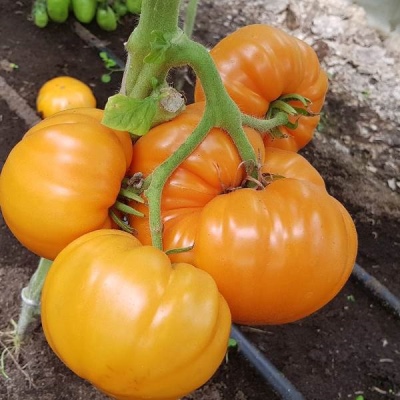
- Authors: A. N. Khovrin, T. A. Tereshonkova, N. N. Klimenko, A. N. Kostenko (LLC Agrofirma "Poisk")
- Year of approval: 2015
- Name synonyms: Bizon oranzhevyy
- Category: grade
- Growth type: indeterminate
- Appointment: fresh consumption, for ketchup and tomato paste
- Ripening period: mid-season
- Ripening time, days: 115-120
- Growing conditions: for film greenhouses
- Bush size: tall
For gardeners interested in creating a beautiful vegetable garden, which is now in trend, the highly decorative indeterminate universal large-fruited variety Bison orange (synonymous with Bizon oranzhevyj) is ideal. Its fruits are not only edible fresh and for canning, but will become a real decoration of the site at the time of ripening, when the tomatoes look like small pumpkins.
Breeding history
In obtaining a unique tomato, the authorship belongs to A. N. Khovrin, T. A. Tereshonkova, N. N. Klimenko, A. N. Kostenko - talented breeders of the company Agrofirma Poisk LLC. Approved Year 2015
Description of the variety
Orange bison is a tall plant, reaching two meters and in need of formation and support. Shoots are covered with medium-sized, not too dense green foliage. The bush forms intermediate inflorescences. The first ovary is formed on 6-7 leaves, all subsequent ones after 1-2 leaves. Each fruit is attached to a stalk, there is an articulation.
The main qualities of the fruit
Large ribbed flat-rounded fruits weighing 280-320 grams are green in an immature state; in the period of technical ripeness they acquire a bright orange color. Tomatoes are distinguished by their ability to be stored and transported for a long time.
Taste characteristics
The dense juicy pulp of medium density has a sweet taste, a pronounced characteristic aroma, 6 or more seed nests.
Ripening and fruiting
The bison is characterized as mid-season - its ripening period is extended, approximately 115-120 days. Harvesting occurs at the end of July and August.
Yield
Tomato Bison orange from one bush gives 6.5 kilograms of fruit.
The timing of planting seedlings and planting in the ground
Sowing works on seedlings fall on the last decade of February and the first decade of March. Seedlings are planted in a permanent place after 55-65 days from the moment of germination.

Growing tomato seedlings is an extremely important process, because it largely depends on whether the gardener will be able to harvest at all. All aspects must be taken into account, from seedbed preparation to planting in the ground.
Landing scheme
Planting holes are dug according to a pattern of 30 cm between the roots and 70 cm between the rows.

Growing and care
Growing Bison is no different from other varieties. Seedlings are planted in the greenhouse in early May or in the latter, if we are talking about the northern regions. Open ground much later. The earth should warm up to 15-17 degrees Celsius.
Planting in a greenhouse is carried out after preparatory measures, as, indeed, in the garden.The earth is dug up, well loosened, river sand is added as necessary to create an air-permeable mixture. Disinfection is carried out with special compounds, grooves, ridges with a height or depth of 35 cm, and a width of 35 cm are formed. This is done in about a week so that the earth finally warms up under the warm rays of the spring sun. After 7 days, young plants can be planted, observing the required distance. In the ridges, holes are made deep on a shovel bayonet, organic matter, mineral fertilizers are added, and supports are installed. Then they planted, fall asleep and compact the earth, spill well with warm water.
They are planted in open ground according to the same principle, with a small difference - it happens much later, sometimes almost for a month - it all depends on the region. It is better to plant on a cloudy day, but this is not always possible. The northern short summer is characterized by hot sunny days in June. In this case, the planting is carried out in the evening, be sure to shade the seedlings from the sun for the next 1.5-2 weeks. Follow-up care consists of traditional activities:
the formation of a bush in 1-2 stems;
pinching and growth control;
watering, weeding, loosening, hilling, fertilizing and sanitizing.
Mulching will save you from the tedious process of loosening, and this technique also allows you to retain moisture.
Top dressing is carried out at least three times per season.
During the growing season, the plant needs nitrogen.
During budding, phosphorus-potassium complex fertilizers are applied.
During filling, tomatoes are fed with compounds containing boron, zinc, magnesium, manganese.
In addition, tomatoes respond gratefully to the introduction of fermented infusions of nettle, weeds, mullein.




A plant needs different micronutrients at each stage of growth. All fertilizers can be divided into two groups: mineral and organic. Folk remedies are often used: iodine, yeast, bird droppings, eggshells.
It is important to observe the rate and period of feeding. This also applies to folk remedies and organic fertilizers.
Disease and pest resistance
The variety resists the tobacco mosaic virus (TMV) well, however, preventive fungicide treatments are necessary to avoid other diseases.


Resistant to adverse weather conditions
Bison tolerates summer temperature drops and short-term dry periods well.
Growing regions
Orange bison is successfully cultivated in almost all regions of Russia. These are the Northern, North-Western, Central, Volgo-Vyatka, Central Black Earth, North Caucasian, Middle Volga, Lower Volga, Ural, West Siberian, East Siberian, Far Eastern regions.

























































































